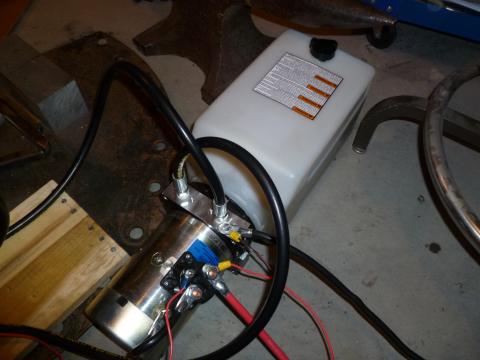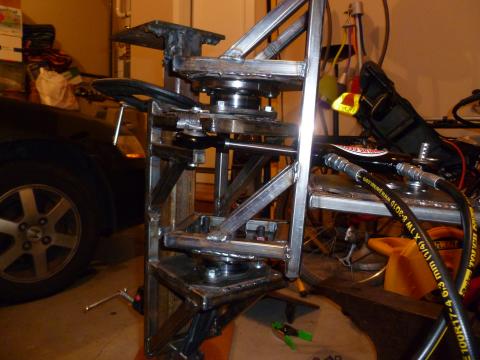That doesn't mean I've stopped working on the hexapod, however, just that I've changed the schedule. Prototyping of the hip joint continues with decent, if slow progress. Most recently I've switched out the teeny tiny hydraulic test platform for something a little bit beefier.

It was sold for powering dump truck bed lifts, with basically no documentation. I'm not sure exactly how many amps it wants, but it's a lot. It works well enough, though. Should be capable of about 1.3 gallons per minute, which is conveniently close to 1/6 the number I've calculated as being required for the entire system. So if a single leg can move at speed being run off this pump, that will be very promising.
The hip joint is really the key to the entire project, as far as I can see. The mechanical design is the trickiest, as unlike the other two leg joints the forces are all parallel to the pivot, making it want to bind. And this is where the top speed of the final device is determined. During a normal stride, the other two joints will only move through maybe 10 degrees, while the horizontal hip joint will travel through upwards of 90. It needs to be a low friction and fast moving.
When dealing with hydraulics, speed is a matter of flow rates. A pump can only move so much hydraulic fluid at pressure per unit time, and that determines how fast a given cylinder will move. The volume a cylinder needs to actuate is simply the area of the bore times the length of travel. The faster the pump can provide that volume, the faster the cylinder moves. Of course, the smaller the bore is, the less force it will apply. And the shorter the travel, the worse the lever moment will be for pivoting something. No free lunch, here or anywhere. Luckily, however, the force being applied by even a very narrow cylinder is much more than I should be needing!

So for this joint I wanted a narrow cylinder, with as short a travel as possible. After poking around online for awhile, I finally found one that was 1" bore by 4" travel. Tiny, but it should still be big enough to do the job. I don't really know, of course, but that's what empirical testing is for! And last night I started on that, hooking up the new pump to the old control valve and electronics and the new cylinder, mounting it for the first time on the prototype hip joint, and giving it a spin. And I managed to do it without either losing a finger or spraying gallons of hydraulic fluid around the garage!
In short, a very real success. That's a full-scale joint running with full-scale hydraulics at a reasonable speed. (Would result in a hexapod walking speed of 3+ mph, depending on the leg length. Though without the other two cylinders running, it's not a very fair test.) I need to get it running using the Arduino PID controller next, to get a sense of how bad the momentum effects are going to be. Assuming that looks good, it's on to prototyping the rest of the leg. Which probably means switching to cartridge valves, which means making a manifold, all kinds of fun stuff. But there are several smaller projects clamoring for my attention this month, so most of that will have to wait.
That's getting pretty scary, but the motion is starting to look like it's going to be a powerful beast. Awesome work.
ReplyDeleteHow do you plan on powering it? Will you use a generator?
This won't be the pump for the final device. I'm going to need at least 8 gallons per minute according to my current calcs, so I'd need another 5 like this one. Plus a huge generator to power them! I'll just get a complete gas-driven hydraulic power unit instead. Gas engine, pump, resevoir, filter, relief valve, drip tray, all in one nice package. Not cheap, but nothing in this project is. :)
ReplyDeleteThis comment has been removed by a blog administrator.
ReplyDelete